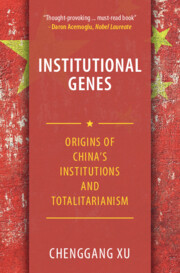Refine search
Actions for selected content:
26945 results in Economic history
Figures and Tables
-
- Book:
- The CEO
- Published online:
- 19 June 2025
- Print publication:
- 19 June 2025, pp vi-vi
-
- Chapter
- Export citation
2 - Gentlemen vs Players
-
- Book:
- The CEO
- Published online:
- 19 June 2025
- Print publication:
- 19 June 2025, pp 17-52
-
- Chapter
- Export citation
7 - Captains of Industry
-
- Book:
- The CEO
- Published online:
- 19 June 2025
- Print publication:
- 19 June 2025, pp 216-238
-
- Chapter
- Export citation
5 - The Buccaneers
-
- Book:
- The CEO
- Published online:
- 19 June 2025
- Print publication:
- 19 June 2025, pp 132-169
-
- Chapter
- Export citation
3 - Families and Founders
-
- Book:
- The CEO
- Published online:
- 19 June 2025
- Print publication:
- 19 June 2025, pp 53-93
-
- Chapter
- Export citation
6 - Fat Cats
-
- Book:
- The CEO
- Published online:
- 19 June 2025
- Print publication:
- 19 June 2025, pp 170-215
-
- Chapter
- Export citation
Bibliography
-
- Book:
- The CEO
- Published online:
- 19 June 2025
- Print publication:
- 19 June 2025, pp 258-274
-
- Chapter
- Export citation
Index
-
- Book:
- The CEO
- Published online:
- 19 June 2025
- Print publication:
- 19 June 2025, pp 275-282
-
- Chapter
- Export citation
1 - Heroes and Villains
-
- Book:
- The CEO
- Published online:
- 19 June 2025
- Print publication:
- 19 June 2025, pp 1-16
-
- Chapter
- Export citation
Contents
-
- Book:
- The CEO
- Published online:
- 19 June 2025
- Print publication:
- 19 June 2025, pp v-v
-
- Chapter
- Export citation
4 - The Managerial Revolution?
-
- Book:
- The CEO
- Published online:
- 19 June 2025
- Print publication:
- 19 June 2025, pp 94-131
-
- Chapter
- Export citation
Portraits
-
- Book:
- The CEO
- Published online:
- 19 June 2025
- Print publication:
- 19 June 2025, pp vii-viii
-
- Chapter
- Export citation

Institutional Genes
- Origins of China's Institutions and Totalitarianism
-
- Published online:
- 03 June 2025
- Print publication:
- 26 June 2025
The Spread of the Modern Central Bank and Global Cooperation, 1919–1939. Edited by Barry Eichengreen and Andreas Kakridis. Cambridge: Cambridge University Press, 2023. xx + 422 pp. Paperback, $34.99. ISBN: 978-1-009-36754-7.
-
- Journal:
- Business History Review / Volume 99 / Issue 2 / Summer 2025
- Published online by Cambridge University Press:
- 29 October 2025, pp. 292-294
- Print publication:
- Summer 2025
-
- Article
- Export citation
The China Firm: American Elites and the Making of British Colonial Society. By Thomas M. Larkin. New York: Columbia University Press, 2024. pp. 336. Paperback, $35.00. ISBN: 978-0-231-21067-6.
-
- Journal:
- Business History Review / Volume 99 / Issue 2 / Summer 2025
- Published online by Cambridge University Press:
- 09 October 2025, pp. 306-308
- Print publication:
- Summer 2025
-
- Article
- Export citation
Towns and Commerce in Viking-Age Scandinavia by Sven Kalmring. Cambridge: Cambridge University Press, 2024. 304 pp. Digital access $29.99. ISBN: 978-1-00-929807-0.
-
- Journal:
- Business History Review / Volume 99 / Issue 2 / Summer 2025
- Published online by Cambridge University Press:
- 29 October 2025, pp. 299-301
- Print publication:
- Summer 2025
-
- Article
- Export citation
The Young Fed: The Banking Crises of the 1920s and the Making of a Lender of Last Resort. By Mark Carlson. Chicago: University of Chicago Press, 2025. xii + 232 pp. Cloth, $40.00. ISBN: 978-0-226-83782-6.
-
- Journal:
- Business History Review / Volume 99 / Issue 2 / Summer 2025
- Published online by Cambridge University Press:
- 29 October 2025, pp. 289-290
- Print publication:
- Summer 2025
-
- Article
- Export citation
BHR volume 99 issue 2 Cover and Front matter
-
- Journal:
- Business History Review / Volume 99 / Issue 2 / Summer 2025
- Published online by Cambridge University Press:
- 29 October 2025, pp. f1-f6
- Print publication:
- Summer 2025
-
- Article
-
- You have access
- Export citation
Capital of Mind: The Idea of a Modern American University. By Adam R. Nelson. Chicago: The University of Chicago Press, 2024. 408 pp. Cloth, $50.00. ISBN: 978-0-226-82920-3.
-
- Journal:
- Business History Review / Volume 99 / Issue 2 / Summer 2025
- Published online by Cambridge University Press:
- 29 October 2025, pp. 308-310
- Print publication:
- Summer 2025
-
- Article
- Export citation
Examining the Impact of Legal Innovations: A Case Study of the Private Limited Liability Company in Vienna, 1900–1936
-
- Journal:
- Business History Review / Volume 99 / Issue 2 / Summer 2025
- Published online by Cambridge University Press:
- 29 October 2025, pp. 211-232
- Print publication:
- Summer 2025
-
- Article
-
- You have access
- Open access
- HTML
- Export citation
